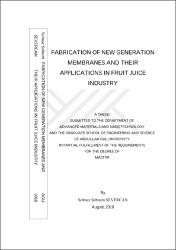| dc.description.abstract | When membrane processes are compared to conventional processes, they have significant advantages for instance, providing decrease in operation time and cost with saving nutritious components and sensory parameters in food production plants. Especially, in fruit juice industry, UF membranes are utilized for clarification by eliminating big molecules like suspend proteins, fat and polysaccharides, which leads turbidity. Although, UF membranes have many advantages like its affordable cost, higher film forming ability, excellent mechanical properties, and superior chemical and thermal resistance, it has a major drawback leading the fouling of the membrane. To get rid of this problem, many researchers focused on the modification of membrane surface to both increase hydrophilicity and enhance antifouling characteristics. In this study, PSF/PEI (20wt%, 2wt%) UF membranes and PSF/PEI (17wt%, 2wt%) MF membranes were prepared with the addition of different concentrations of TiO2 and Al2O3 nanoparticles (0.01, 0.03, 0.05 wt %) using phase inversion method to alter the structural and morphological properties of membranes. Turbid apple and pomegranate juice samples supplied from Döhler Inc. (Karaman, Turkey) were clarified by using cross flow membrane filtration system and dead-end filtration system at 5.4 bar transmembrane pressure, respectively. Prepared nanocomposite membranes were characterized by using scanning electron microscopy (SEM), fourier transform infrared spectroscopy (FT-IR), water-contact angle porosity and pure water flux. To investigate fouling resistance of nanocomposite membranes flux recovery ratio (FRR), flux decay ratio (DR), relative flux reduction (RFR) values were also calculated. In addition, ii clarified apple and pomegranate juice samples were characterized in terms of color, turbidity, total soluble solid, total antioxidant capacity (ABTS radical scavenging method and DPPH radical scavenging method) and total phenolic content. Total monomeric anthocyanin pigment content of pomegranate juice was also determined. The clarified juices obtained using new generation nanocomposite membranes were compared with the clarified product juice samples supplied from Döhler Inc. Membrane characterization and fruit juice characterization results demonstrated that fabricated new generation nanocomposite membranes were effective in apple and pomegranate juice clarification. Among these fabricated new generation nanocomposite membranes, the ones prepared with the addition of 0.01% of TiO2 UF membrane and prepared with the addition of 0.05% Al2O3 MF membrane exhibits superior performance in terms of clarification of apple juice and pomegranate juice, respectively. | en_US |


















